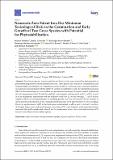Por favor, use este identificador para citar o enlazar a este item:
http://hdl.handle.net/10261/218451COMPARTIR / EXPORTAR:
 SHARE SHARE
 CORE
BASE CORE
BASE
|
|
| Visualizar otros formatos: MARC | Dublin Core | RDF | ORE | MODS | METS | DIDL | DATACITE | |

| Título: | Nanoscale Zero-Valent Iron Has Minimum Toxicological Risk on the Germination and Early Growth of Two Grass Species with Potential for Phytostabilization |
Autor: | Teodoro, Manuel; Clemente Carrillo, Rafael CSIC ORCID; Ferrer-Bustins, Ermengol; Vítková, Martina; Vítek, Petr; Komárek, Michael; Martínez-Fernández, Domingo; Bernal Calderón, M. Pilar CSIC ORCID | Palabras clave: | Nano zerovalent iron Plant stress Uptake Agrostis capillaris Festuca rubra |
Fecha de publicación: | 5-ago-2020 | Editor: | Multidisciplinary Digital Publishing Institute | Citación: | Nanomaterials 10 (8): 1537 (2020) | Resumen: | Two <i>Poaceae</i> species, <i>Agrostis capillaris</i> and <i>Festuca rubra</i>, were selected for their potential as phytostabilizing plants in multicontaminated soils. These species are resistant to contamination and maintain high concentrations of contaminants at the root level. Nanoscale zero-valent iron (nZVI) is an engineered nanomaterial with the ability to stabilize metal(loid)s in soils; its potential toxicological effects in the selected species were studied in a germination test using: (i) control variant without soil; (ii) soil contaminated with Pb and Zn; and (iii) contaminated soil amended with 1% nZVI, as well as in an hydroponic experiment with the addition of nZVI 0, 25, 50 and 100 mg L<sup>−1</sup>. nZVI had no negative effects on seed germination or seedling growth, but was associated with an increase in shoot growth and reduction of the elongation inhibition rate (root-dependent) of <i>F. rubra</i> seedlings. However, applications of nZVI in the hydroponic solution had no effects on <i>F. rubra</i> but <i>A. capillaris</i> developed longer roots and more biomass. Increasing nZVI concentrations in the growing solution increased Mg and Fe uptake and reduced the Fe translocation factor. Our results indicate that nZVI has few toxic effects on the studied species. | Versión del editor: | https://doi.org/10.3390/nano10081537 | URI: | http://hdl.handle.net/10261/218451 | DOI: | 10.3390/nano10081537 | E-ISSN: | 2079-4991 | Identificadores: | doi: 10.3390/nano10081537 |
| Aparece en las colecciones: | (CEBAS) Artículos |
Ficheros en este ítem:
| Fichero | Descripción | Tamaño | Formato | |
|---|---|---|---|---|
| nanomaterials-10-01537.pdf | 2,48 MB | Adobe PDF |  Visualizar/Abrir |
CORE Recommender
PubMed Central
Citations
3
checked on 22-abr-2024
SCOPUSTM
Citations
9
checked on 20-abr-2024
WEB OF SCIENCETM
Citations
8
checked on 27-feb-2024
Page view(s)
136
checked on 24-abr-2024
Download(s)
107
checked on 24-abr-2024

